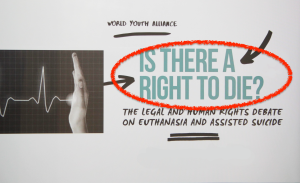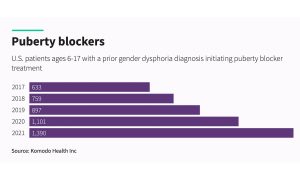Those Suffering at the End of Life need Palliative Care, not Euthanasia
In previous articles we have discussed what the social consequences of legalizing euthanasia are and examined why there is no such thing as the “right to die” in international law.
Our investigations led us to inevitably conclude that euthanasia is not the adequate solution to the problems of the end of life.
This of course doesn’t mean that there is no solution for the people who are suffering in that phase of their life. Quite the contrary, the solution is to alleviate their pain and suffering through palliative care.
Palliative care was the approach established by Dame Cicely Saunders in 1967 in Great Britain.[1] She argued that we should approach the question of pain in a comprehensive way and developed the concept of “total pain,” which encompasses physical, mental, emotional and spiritual pain.
The adequate response to “total pain” is consequently “total care,” which aims to address all the aspects of the pain the patient is experiencing.
But, before we go any further, let’s examine some of the usual concepts connected to the end of life care.
Clarifying terminology
Two notions which inevitably arise in the debate are “death” and “dying.” Although they are sometimes understood as synonyms, these are two different things. “Death” signifies the moment in which life ends and “dying” is the process of the gradual deterioration of life, usually accompanied by pain, sickness, and psychological suffering
Many organizations, those for euthanasia and those against it alike, have used the term “dying with dignity” to describe the dying conditions worthy of man.
This concept is inherently problematic, regardless of whether we include euthanasia in the concept of “dying with dignity” or not. It is problematic because it suggests that there could equally be a situation in which a person could die “without dignity”. This is mistaken, because a human person is never “without” his or her dignity.
As the WYA Charter states, human dignity is inalienable, intrinsic and universal. Human dignity can obviously be disrespected or not recognized, but this doesn’t change the fact that even the gravest injustices towards man don’t deprive him of his dignity.
It is important to grasp this distinction, since the opposite view can suggest that rights given to man by the society, conditions he finds himself in or the level of his well-being can grant or rescind his dignity. Quite the contrary is true, human dignity is prior to all the mentioned things.
Human rights, living and dying conditions, and well-being all must be conformed to the human dignity. Thus, in the context of our discussion, we can recognize that there are ways of dying in accordance with human dignity and those that aren’t.
Palliative care recognizes that a person is never without human dignity.
Equally wrongis the term “dignified death” or “dignity of death.” As we defined it before, death is the moment in which human life ends.
Death itself, considered biologically, is “the degradation of the biological dimension of the human being, nothing dignified.”[2] In all the other aspects (psychological, emotional, social and mental) death also indicates disintegration of man. Even if we consider that in the spiritual sense, death is a blessing for a man because it opens for him the door of a certain kind of afterlife, again it’s not that death is worthy in itself, but it receives worth from the fact of the afterlife.
Since life is a fundamental value for a man (there can be no non-living man; a dead body is a corpse and not a dead man) and death signifies the moment in which this fundamental value ceases to exist, there is nothing of dignity in the death per se.
Thus, concepts of “dignified death” and the “dignity of death” should be abandoned.
Rather, we should talk about respect for dignity in end of life care. The process of dying can be more or less in accordance with human dignity, and thus can be more or less respectful of human dignity.
What we should aim for is the end of life care which ensures a high level of this respect for human dignity for those who are dying, so that end of life care is understood as process of dying in accordance with human dignity or process of dying worthy of human person.
Now, we are ready to examine hospice and palliative care as the end of life care which ensures this respect.
Definition of hospice and palliative care
For a long time in the past, people from different cultures and different places have tried to assist their closest ones in the time of their dying, and especially, in the time when they experienced suffering and pain.
In a variety of different circumstances the institution of hospice was created.[3] Among a variety of definitions, the following are to be found:
“The term ‘hospice’ is today used as a ‘certain notion of medial, nursing and spiritual care, a certain attitude to death and care for the dying’”.[4]
The term palliative care, “or an efficient pain management, describes a medical skill of an optimized expert use of drugs intended to remove or diminish pain, or to put it simple to improve the life quality. The combination of medical palliative care and human hospice care produces a complete human care and love for the sick and the dying. It is the realization of the culture of living in this area. The man lives in the time of his dying as well.”[5]
It is generally understood that while curative medicine aims at curing the disease, the palliative medicine aims at alleviating the pain and suffering.[6]
The World Health Organization offers this comprehensive definition of palliative care:
“Palliative care is an approach that improves the quality of life of patients and their families facing the problem associated with life-threatening illness, through the prevention and relief of suffering by means of early identification and impeccable assessment and treatment of pain and other problems, physical, psychosocial and spiritual. Palliative care:
- provides relief from pain and other distressing symptoms;
- affirms life and regards dying as a normal process;
- intends neither to hasten or postpone death;
- integrates the psychological and spiritual aspects of patient care;
- offers a support system to help patients live as actively as possible until death;
- offers a support system to help the family cope during the patient’s illness and in their own bereavement;
- uses a team approach to address the needs of patients and their families, including bereavement counselling, if indicated;
- will enhance quality of life, and may also positively influence the course of illness;
- is applicable early in the course of illness, in conjunction with other therapies that are intended to prolong life, such as chemotherapy or radiation therapy, and includes those investigations needed to better understand and manage distressing clinical complications.”
Other authors give a similar definition: “Following the definition of the World Health Organization (WHO), palliative care is an approach that improves the quality of life of patients and their families facing the problems associated with life-threatening illness, through the prevention and relief of suffering by means of early identification and impeccable assessment and treatment of pain and other problems, physical, psychosocial and spiritual.”[7]
In this context, it is also worthy to note that some authors have suggested introducing the model of “integral palliative care, in which euthanasia is considered as another option at the end of a palliative care pathway.”[8]
Can we Make Euthanasia an Option Under Palliative Care?
Since palliative care is aimed primarily at alleviating pain and not curing the patient, underlying presupposition of this approach is that euthanasia also has the intention to remove pain and thus is complementary to the palliative care approach.
However, this view is deeply problematic, and suggests, wrongly, that euthanasia achieves the same ends as palliative care.
Euthanasia is the action or omission by the doctor (or a third person) which, by definition, has the “intent to cause or hasten patient’s death.”[9]
On the other hand, already from the WHO definition we can see that palliative care “intends neither to hasten or postpone death”, which is also affirmed in other definitions of palliative care.[10]
It would be more correct to say that euthanasia removes the patient instead removing his or her pain, and palliative care tries to remove or alleviate pain, while at the same time “affirming [the] life” (according to the WHO definition) of the patient.
For this reason, the European Association for Palliative Care (EAPC) rejects euthanasia as a part of palliative care approach, highlighting that “palliative care clinicians in other countries are concerned about these proposals, as their clinical experience in palliative care has taught them to be sensitive in the acknowledgement but also very careful with the interpretation of the request for euthanasia from palliative care patients.”[11]
Instead, EAPC “stresses the importance of refocusing attention onto the responsibility of all societies to provide care for their older, dying and vulnerable citizens. A major component in achieving this is the establishment of palliative care within the mainstream healthcare systems of all European countries supported by appropriate finance, education and research.”[12]
They claim that realizing this goal is one of the most powerful alternatives to calls for the legalization of euthanasia and physician assisted suicide (PAS). The Parliamentary Assembly of the Council of Europe in the Recommendation 1418 (1999) similarly rejected euthanasia “by upholding the prohibition against intentionally taking the life of terminally ill or dying persons, while:
- recognising that the right to life, especially with regard to a terminally ill or dying person, is guaranteed by the member states, in accordance with Article 2 of the European Convention on Human Rights, which states that “no one shall be deprived of his life intentionally”;
- recognising that a terminally ill or dying person’s wish to die never constitutes any legal claim to die at the hand of another person;
- recognising that a terminally ill or dying person’s wish to die cannot of itself constitute a legal justification to carry out actions intended to bring about death.”
Palliative care meets human rights standards
The EAPC also advocates for access to adequate palliative care for all who need in order to meet human rights standards.[13] “Good provision of palliative care is paramount in order to ensure that people don’t ask for euthanasia through lack of optimal symptom control or private or societal marginalization.”[14]
Similarly, the Parliamentary Assemble of the Council of Europe in its Recommendation 1418 to the Committee of Ministers recommends “recognising and protecting a terminally ill or dying person’s right to comprehensive palliative care.”
In the same way, The Prague Charter, agreed by palliative care experts in 2013, states that ‘access to palliative care is a human right under the right to the highest attainable standard of physical and mental health. In certain cases, where patients face severe pain, failure to provide palliative care can constitute cruel, inhuman and degrading treatment’
In the PACE Resolution; “Palliative Care: A model for innovative health and social policies Resolution 1649 (2009)”, the report indicates the need for the development of palliative care in all European countries, to make palliative care available for all patients with life-threatening diseases who need it.
The report commends palliative care as an innovative new way, which can be used as a model for other areas of health care. Palliative care “approach is not… just based on need, but contributes directly to human, civic and participation rights being asserted right up to death.”
PACE Recommendation 779 (1976) equally insists that “prolongation of life should not in itself constitute the exclusive aim of medical practice, which must be concerned equally with the relief of suffering”, and recommends that the Committee of Ministers “invites the governments of the member states to take all necessary action… to ensure that all sick persons, whether in hospital or in their own homes, receive relief of their suffering as effective as the current state of medical knowledge permits.”
The Parliamentary Assembly recognizes in its Recommendation Rec(2003)24) of the Committee of Ministers to member States on the organisation of Palliative Care that palliative care is a vital and integral part of health services and that any person who needs palliative care should be able to access such care without undue bureaucracy or delay, and in a setting that is consistent with individual need and choice.
The Assembly further recognizes that the appropriate, normative and internationally recognized best practice of palliative care is consistent with the human dignity and rights of seriously ill people.
The mentioned PACE Recommendations and Reservations are important because they are taken into account in the rulings of the European Court of Human Rights, which is more and more dealing with the cases related to the end of life care.
Also, the Recommendations are considered as a common voice of all 47 Council of Europe governments and provide the directions which the members States are called to adopt.
Best practices for implementing palliative care
Despite the recommendations mentioned above, there remain significant disparities between countries regarding the provision of appropriate standards of palliative care.
Recent estimations show that for the adequate palliative and hospice care 80 to 100 beds are needed on every 1.000.000 people. According to the estimations, between 50% and 89% of all dying patients need some kind of palliative care.[16]
The results of the study of the European Association for Palliative Care Task Force revealed that, among 52 European countries, only five countries have a well-developed and extensive network of inpatient hospices.[17]
Poland is today the leading European country in organizing the system of palliative care and the number of hospices, which there are almost 620.[18] Almost every town in Poland with more than 10.000 inhabitants has its own hospice and house palliative care.[19] In comparison, the Great Britain, the home of the hospice movement, today has 220 palliative care units with 3156 available beds.[20]
Palliative care is always interdisciplinary in its approach and it has to include the patient, the family and the community in its scope. It has to offer the most basic concept of care – that of providing for the needs of the patient wherever he or she is cared for, either at home or in the hospital.[21]
Hospice care is the care “for the whole person, aiming to meet all needs – physical, emotional, social and spiritual. At home, in day care and in the hospice, they care for the person who is facing the end of life and for those who love them. Staff and volunteers work in multiprofessional teams to provide care based on individual need and personal choice, striving to offer freedom from pain, dignity, peace and calm.“[22]
There are several principles agreed by palliative care experts which portray the approach which palliative care should take:[23]
- Respect for the patient’s autonomy and self-determination.
- Respect, openness and sensitivity for personal, cultural and religious values, beliefs and practices as well as the law of each country.
- Collaborative relationship with patients and families.
- A central goal of palliative care is to achieve, to support, to preserve and to enhance the best possible quality of life.
- Palliative care seeks neither to hasten death nor to postpone it.
- Good communication between patient, healthcare professionals, relatives and different healthcare professionals are an essential prerequisite for quality palliative care.
- Palliative care is supposed to be provided within a multiprofessional and interdisciplinary framework.
- Public education which is essential to build community capacity and to promote preventive healthcare.
- Palliative care offers support to family and other close carers during the patient’s illness, helps them prepare for loss and continues to provide bereavement support, where required, after the patient’s death.
The Philosophy of Palliative Care
The philosophy of hospices and palliative care has its basis in the statement „You are important since You are You“. In such an atmosphere a person can feel acknowledged and loved even if caught in the inevitable circumstances of physical and spiritual weakening.[24]
Palliative care should be provided on different levels, whereby minimum two levels should be provided: general palliative care and specialist palliative care.[25]
General palliative care is provided by primary care professionals and specialists treating patients with life-threatening diseases who have good basic palliative care skills and knowledge.
Specialist palliative care is provided by specialised services for patients with complex problems not adequately covered by other treatment options. Generally, a palliative care team should be an interdisciplinary team consisting of, but not limited to, physicians/medical doctors, nurses, social workers, physiotherapists, spiritual advisors and volunteers.
The terms “palliative care” encompasses the activities of the whole team.[26]
In order to establish a good palliative care system, we recommend that at least the following should be implemented:
- Education and training of doctors, nurses and all involved stakeholders in palliative care treatment and philosophy
- Adequate number of trained and committed volunteers
- Political commitment on a local, regional, national and supra-national level to develop adequate palliative-care strategies and implement quality standards
- Public education to sensitize the general public to accept dying as a natural process and promote palliative care approach
- Adequate public and private funding for the hospices and palliative care centres
- Establish diverse palliative care units, including palliative care centres in bigger hospitals, and hospices at home of the patient
- Involving friends and family of the patient in all stages of the care
- Treating all aspects of pain and suffering, including physical, emotional, mental and spiritual pain
Avoiding overly aggressive therapy
As WHO definition stresses “palliative care intends neither to hasten death nor to postpone it.” Similarly, PACE Recommendation 779 (1976) claims that “the prolongation of life should not in itself constitute the exclusive aim of medical practice, which must be concerned equally with the relief of suffering”.
From these brief notes we can see that palliative care doesn’t aim to prolong life at all costs. There are situations in which we must acknowledge the limitations of technology and medical science and accept the inevitability of death.
These situations are usually referred to as “dystanasia”, “medical futility”, “therapeutic insistence” or “overly aggressive therapy”.
These terms signify “medical behaviour which consists of using therapeutic procedures which effect brings more harm than the effect of the disease that needs to be treated, or it is useless, because the treatment is impossible and the expected utility is lesser than the anticipated problems.”[27]
The treatment is considered futile when it cannot achieve real chances of bringing the effect which would be considered useful by the patient and bring him the welfare in the therapeutic sense.[28]
Three conditions need to be met, that a procedure can be considered as dystanasia[29]:
- Futility in the therapeutic sense
- Additional pain inflicted on the patient
- Disproportionality of the means to the expected outcome of the treatment
Dystanasia is widely opposed by various medical associations worldwide, such as the American Thoracic Society[30], the American Medical Association[31], theHastings Center[32], the Society of Critical Care Medicine[33], etc.
Prolonging life at all costs, puts value only on the “quantitative” aspect of life, disregarding the “quality” of life, thus sacrificing human dignity in the name of quantity of biological life.[34] Euthanasia, on the other hand, is concerned only with the quality of life without respecting the value of life as such.[35]
Abandoning “overly aggressive therapy” should be clearly distinguished from euthanasia by omission. As John Finnis notes: “This inclusion [in the definition of euthanasia] of ‘non-activities’, omissions, ‘passive’ conduct, is entirely reasonable. Euthanasia, on any view, is an exception or proposed exception to the law of homicide, more specifically the law of murder. And you can unquestionably commit murder by omission.
Parents murder children sometimes with a pillow but sometimes by starvation, omitting to feed them. To inherit the fortune, I omit to give the diabetic child his insulin. To be free to marry his secretary, Dr D. omits to switch his wife’s life-support system back on after its daily service break. The core concept in the law of murder, everywhere, is intention to cause death. Causation-starvation, dehydration, insulin shock-plus intention: murder by omission. Of course, the accused must have had control over the deceased—care or an acknowledged, fulfillable duty of care-otherwise there’s no intention but at most a wish. In short, to make euthanasia lawful, the desired exception to the law of murder needs to cover cases of omission with intent to terminate life.”[36]
The radical difference between euthanasia by omission is that it intends to cause death. Abandoning medically futile treatment, on the other hand, doesn’t intend to cause of hasten death, it only accepts it as something inevitable. At the same time, basic care (such as nutrition. hydration, dialysis etc.) is always provided to the patient, event when therapeutic treatment is removed.
Orthothanasia (from greek orthos = right and thanatos = death) is a normal or natural way of dying. According the Spanish theologian Marciano Vidal, orthothanasia is an “ethical synthesis of the right to dignified dying and respecting human life.”[37]
It thus seeks to bring these two principles in harmony and ensure the foundations for the quality prudential judgements on when it is legitimate to stop prolonging life.
This is especially needed in the situations like the recent one with Charlie Gard, where there is no consensus between different involved parties on what should be done.
Always to care for, and never to kill, the patient is the imperative; but there is also an obligation to avoid the disproportionate and futile treatments, which cause additional suffering.
Previous articles in the “Debating Death” series:
#1: Should Liberal Societies Legalize Euthanasia?
#2: How will Legal Euthanasia Affect the Medical Profession?
#3: What are the Social Consequences of Euthanasia?
#4: Is There a “Right to Die” in the International Law?
[1] Jušić, A., Eutanazija, Rev. sac. polit., Zagreb 2002., 9, 3-4, pp. 307. See also: Association for Palliative Care, White Paper on standards and norms for hospice and palliative care in Europe: part 1. Recommendations from the European Association for Palliative Care, u: European Journal of Palliative Care, 2009., 16 (6), 278.
[2] Pozaić, V., Palliative care and the human dignity of patients, Glas. pul. boln. 2009., Vol. V/2, pp.154.
[3] Ibid., pp. 153.
[4] Student J-C., Hospiz/Hospizbewegung, u: Lexikon. Medizin. Ethik. Recht, Herder, Freiburg-Basel-Wien 1989, pp. 480-481.
[5] Pozaić V., Palliative care and the human dignity of patients, Glas. pul. boln. 2009., Vol. V/2, pp. 153.
[6] Brkljačić M., Bioetika i bioetički aspekti palijativne medicine, medicina 2008, Vol. 44, No. 2, pp. 149.
[7] Sepulveda C, Marlin A, Yoshida T, et al. Palliative Care: the World Health Organization’s global perspective. J Pain Symptom Manag 2002; 24: 91–96.
[8] Bernheim JL, Deschepper R, Distelmans W, et al. Development of palliative care and legalisation of euthanasia: antagonism or synergy? BMJ 2008; 336: 864–867.
[9] Perico G., Problemi di etica sanitaria, Editrice Ancora, Milano, 1992, pp. 138. See also: Cattorini P., Qualita di vita negli ultimi instanti, in: Medicina e Morale, 1989, 2, pp. 273.
[10] See: Pastrana T, Junger S, Ostgathe C, et al. A matter of definition – key elements identified in a discourse analysis of definitions of palliative care. Palliat Med 2008; 22: 222–232.
[11] Radbruch L, Leget C, et al. Euthanasia and physician-assisted suicide: A white paper from the European Association for Palliative Care, Palliative Medicine 2015; 8-9.
[12] Ibid., pp. 11.
[13] Radbruch L, de Lima L, Lohmann D, et al. The Prague Charter: urging governments to relieve suffering and ensure the right to palliative care. Palliat Med 2013; 27: 101–102.
[14] Radbruch L, Leget C, et al. Euthanasia and physician-assisted suicide: A white paper from the European Association for Palliative Care, Palliative Medicine 2015; 11.
[15] See: Vuletić S., Juranić B., et al., Palijativna skrb i medicinsko-duhovne potrebe terminalnih bolesnika, Bogoslovska smotra, 84 (2014.) 4, 889.
[16] Ibid., 892.
[17] Association for Palliative Care, White Paper on standards and norms for hospice and palliative care in Europe: part 1. Recommendations from the European Association for Palliative Care, u: European Journal of Palliative Care, 2009., 16 (6), 280.
[18] Brkljačić M., Current state of palliative care in Croatia, Služba Božja 53 (2013.), br. 3/4, str. 374.
[19] Ibid.
[20] Ibid.
[21] See: Association for Palliative Care, White Paper on standards and norms for hospice and palliative care in Europe: part 1. Recommendations from the European Association for Palliative Care, u: European Journal of Palliative Care, 2009., 16 (6), 280.
[22] Centeno C, Clark D, Lynch T et al. EAPC Atlas of Palliative Care in Europe. Houston: IAHPC Press, 2007.
[23] See: Association for Palliative Care, White Paper on standards and norms for hospice and palliative care in Europe: part 1. Recommendations from the European Association for Palliative Care, u: European Journal of Palliative Care, 2009., 16 (6), 283.
[24] Pozaić, V., Palliative care and the human dignity of patients, Glas. pul. boln. 2009., Vol. V/2, pp.154.
[25] Association for Palliative Care, White Paper on standards and norms for hospice and palliative care in Europe: part 1. Recommendations from the European Association for Palliative Care, u: European Journal of Palliative Care, 2009., 16 (6), 285.
[26] Jušić A., Palliative Medicine – Palliative Care, Medicus, 2001., Vol. 10, No. 2, 247.
[27] Moratti S., The development of »medical futility«: towards a procedural approach based on the role of the medical profession, u: Journal of Medical Ethics 35(2009.), str. 369.-372.
[28] Schneiderman L., Defining Medical Futility and Improving medical care, in: Bioethical Inquiry 8 (2011.), pp. 123.-131.
[29] Vuletić S., Juranić B., et al., Biomedicinski i moralno-etički aspekti distanazije. U agoniji umiranja pred medicinskom beskorisnošću, Diacovensia, 2014., 22 (2), pp. 164.
[30] American Thoracic Society Bioethics Task Force, Witholding and withdrawing life-sustaining therapy, u: Annals of Internal medicine 115, 1991., 6, pp. 478.-485.
[31] Council On Ethical And Judical Affairs – American Medical Associacion, Guidelines for the appropriate use of do-not-resuscitate orders, u: Journal of the American Medical Association 265, 1991., 14, pp. 1868.-1871.
[32] Hastings Center, Guidelines on the terminantion of life-sustaining treatment and the care of the
dying, Indiana University Press, Bloomington, 1987.
[33] Task Force On Ethics Of The Society Of Critical Care Medicine, Consensus report on the ethics of foregoing life-sustaining treatments in the critically ill, u: Critical care Medicine 18, 1990., 12, pp. 1435.-1439.
[34] Pessini L., Distanazija. Do kada produžavati život?, Adamić, Rijeka, 2004., pp.177.
[35] Vuletić S., Juranić B., et al., Biomedicinski i moralno-etički aspekti distanazije. U agoniji umiranja pred medicinskom beskorisnošću, Diacovensia, 2014., 22 (2), pp. 179.
[36] Finnis J., Euthanasia, Morality and Law, 1998., Journal Articles. Paper 516, pp. 1127.
[37] See: Vidal M., Eutanásia: um desafio para a consciéncia, Santuário, 1996., 98–103.








